CandaGrowSmart | Right Plants in the Right PlacePesticide Alternative Hotline (604)463-2229 |
|
A plant whose cultural needs are not met-- for sun or shade, moisture or dryness, drainage, protection from wind-- will never thrive. Unhealthy plants are generally more susceptible to pests and disease.
Planning a great garden starts on paper. Map your yard, identifying the site conditions mentioned above. As you consider plants and their placement, take into account the mature size of the plants so you won’t overcrowd them, to avoid ongoing-- and often unattractive-- pruning and shaping. Also remember that all plants need regular watering until they are established-- from one to three years. By using the right plant in the right place, in combination with good soil preparation and mulching practices, your landscape should need relatively little supplemental watering after establishment. Actual watering needs will depend on specific site conditions and the plants used. |
Group plants by their needs
Put plants that need full sun, or shade, or rich soil, or regular irrigation together with those of similar needs. That way you won't have to water the whole yard to reach one thirsty plant!
How much lawn do you need, or want to maintain? What kind of plantings would fit your yard?
Plant right for your site
Get to Know Your Yard
What About Lawns and Vegetable Gardens?
Choosing a garden site
Picking out a place for a garden is easy if you think about four important things: sunlight, soil, water and access.
Sunlight
Most vegetable crops need at least five to six hours of direct sunlight a day (assuming a cloudless day). Areas receiving less sunlight than this should be considered for a composting site or work area. Leaf leaf and root vegetables ( lettuce, peas, carrots, kale, Swiss chard ) can tolerate some shade, but vegetables that produce fruit ( tomatoes, peppers, eggplant, squash ) require full sun. If your garden site is too shady, think about whether you can remove the shading fence, shrub or tree. Maybe just pruning a few branches will help. (Remember to ask your landlord or neighbour before cutting a tree on someone else's property.) Light can be improved a lot by painting nearby walls or fences white.
Soil
Of all the resources in the garden, soil is the easiest to improve. You can always make the soil and its drainage better by adding organic matter (decomposed leaves or sawdust, compost, aged manure). If you can dig a shovel's depth down (about 12 inches) into your soil without breaking your back or the shovel, or reaching puddled water, then you can probably grow vegetables in it with minor additions. If the ground is constantly wet, or too rocky for a shovel to penetrate, you will probably need to add a substantial amount of organic matter or build raised beds.
Water
Although you don't want too much water in your soil, you do need to think about watering when it is required. Is there a water spigot handy in your garden? How much hose do you need to reach the whole garden? If the spigot is in an inconvenient place, you may want to extend the line with PVC pipe and put a spigot or standpipe nearer the garden site.
Access
Don't forget that you have to get things in and out of the garden--often big, heavy things like wheelbarrows of compost. Identify the shortest route between your compost area and a loading area in the street or driveway. Keep this path open when you lay out planting areas. You may have to cut a path through shrubs or put a gate in a fence, but it is worth the effort to shorten hauling distances.
Another thing to consider is how accessible your garden is to pests, both the animal kind and the human kind. Low barriers will keep dogs out, but humans are more persistent. If you have trouble, enlist neighbors to help in your garden for a share of the produce. (Having someone there a lot keeps out vandals.)
Put plants that need full sun, or shade, or rich soil, or regular irrigation together with those of similar needs. That way you won't have to water the whole yard to reach one thirsty plant!
How much lawn do you need, or want to maintain? What kind of plantings would fit your yard?
Plant right for your site
Get to Know Your Yard
- Where is it sunny and shady?
- Where is the soil sandy or clay-bound?
- Are there pockets of dry or soggy soil?
- Place large-growing plants away from your house to avoid constant pruning.
- Select native or Northwest-adapted plants that grow well in our climate.
- Choose plants that resist pests and use less water.
- Group plants by their sun/shade, soil and water needs.
- Mix some compost into planting beds.
- Spread out roots.
- Add water.
- Tamp soil down lightly for good root contact (leave air pockets; roots need air too).
What About Lawns and Vegetable Gardens?
- Lawns and vegetable gardens need irrigation, several hours of full sun and level well-drained soil.
- Limit lawn areas to locations where you need them.
Choosing a garden site
Picking out a place for a garden is easy if you think about four important things: sunlight, soil, water and access.
Sunlight
Most vegetable crops need at least five to six hours of direct sunlight a day (assuming a cloudless day). Areas receiving less sunlight than this should be considered for a composting site or work area. Leaf leaf and root vegetables ( lettuce, peas, carrots, kale, Swiss chard ) can tolerate some shade, but vegetables that produce fruit ( tomatoes, peppers, eggplant, squash ) require full sun. If your garden site is too shady, think about whether you can remove the shading fence, shrub or tree. Maybe just pruning a few branches will help. (Remember to ask your landlord or neighbour before cutting a tree on someone else's property.) Light can be improved a lot by painting nearby walls or fences white.
Soil
Of all the resources in the garden, soil is the easiest to improve. You can always make the soil and its drainage better by adding organic matter (decomposed leaves or sawdust, compost, aged manure). If you can dig a shovel's depth down (about 12 inches) into your soil without breaking your back or the shovel, or reaching puddled water, then you can probably grow vegetables in it with minor additions. If the ground is constantly wet, or too rocky for a shovel to penetrate, you will probably need to add a substantial amount of organic matter or build raised beds.
Water
Although you don't want too much water in your soil, you do need to think about watering when it is required. Is there a water spigot handy in your garden? How much hose do you need to reach the whole garden? If the spigot is in an inconvenient place, you may want to extend the line with PVC pipe and put a spigot or standpipe nearer the garden site.
Access
Don't forget that you have to get things in and out of the garden--often big, heavy things like wheelbarrows of compost. Identify the shortest route between your compost area and a loading area in the street or driveway. Keep this path open when you lay out planting areas. You may have to cut a path through shrubs or put a gate in a fence, but it is worth the effort to shorten hauling distances.
Another thing to consider is how accessible your garden is to pests, both the animal kind and the human kind. Low barriers will keep dogs out, but humans are more persistent. If you have trouble, enlist neighbors to help in your garden for a share of the produce. (Having someone there a lot keeps out vandals.)
Additional Resources
|
Choosing the right plants.
|
A selection of 240 plants and their growing conditions.
| ||||||||||||

